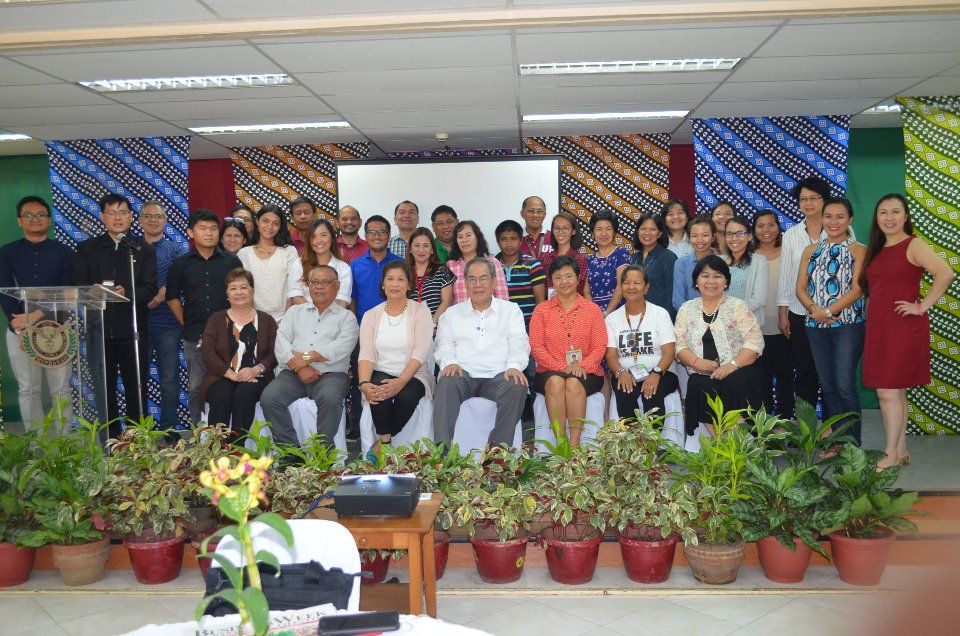 UP Forum on Food Security for Sustainable Development with (seated, left-right) Aleli Quirante, Joe Palabao, Dean Elena Pernia, VP for Public Affairs Jose “Butch” Dalisay, Chancellor Sylvia Concepcion, Alma Mahinay, Odette Portus and the participants. (Rene Estremera)
UP Forum on Food Security for Sustainable Development with (seated, left-right) Aleli Quirante, Joe Palabao, Dean Elena Pernia, VP for Public Affairs Jose “Butch” Dalisay, Chancellor Sylvia Concepcion, Alma Mahinay, Odette Portus and the participants. (Rene Estremera)
Food security forum held in UP Mindanao

UP Forum on Food Security for Sustainable Development with (seated, left-right) Aleli Quirante, Joe Palabao, Dean Elena Pernia, VP for Public Affairs Jose “Butch” Dalisay, Chancellor Sylvia Concepcion, Alma Mahinay, Odette Portus and the participants. (Rene Estremera)
A Media Reception and Forum on Food Security for Sustainable Development was hosted by UP-Mindanao this month of July 6. In the opening, UP Vice-President for Public Affairs Jose “Butch” Dalisay delivered a message from UP President Danilo Concepcion whom he said would have been interested to hear the talks as “a man of science, having been an agricultural engineer before becoming a lawyer.” Through these forums, continued VP Dalisay, UP aimed to “bridge the gap between the academe and the general public.”
UP-Mindanao faculty members reported on their research studies in the forum proper. Prof. Juma Novie Alviola presented “Utilization of sago flour to improve the nutritional profile of selected food products”. The study focused on flours from sago, kamote, rice, munggo, cardaba, and wheat. The study considered the prices, and the combinations of glutens, carbohydrates, proteins, fiber, and antioxidants, for the best nutritional outcomes. She also mentioned the uses of sago starch for lactic acid, cosmetics, glucose, and animal feeds, and of the sago palm to alleviate global warming and climate change.
Prof. Bayogan presented the study, “Post-harvest of pummelo fruit treated with chitosan and i-methylcyclopropene”. The study aims to reduce crop losses–that currently average about 35% of farm produce—through the use of these low-cost compounds. Pummelo, being a high-value crop in the region, had much longer shelf-life and maintained its sweetness and juiciness after being given the right measure of these compounds.
Prof. Nañola, for his part, reported on “Exploring the connectivity of reef fish populations along eastern and southern coast of Mindanao”. These are the “isdang bato”—the damselfish, parrotfish, and surgeon fish found in the coral reefs of Sarangani Bay, Davao Gulf, and Pujada Bay. The study recommended regulations that would limit commercial fishing to fully-grown fishes and the protection of coral reefs in order to avoid depletion of the local fish population.
The open forum heard questions from the media persons who attended: Boom Castillo (Sun Star Davao), Yas Ocampo (Mindanao Times/Manila Bulletin), Joe Palabao (Business Week Mindanao/Mindanao Daily), Nitz Escarpe (DXRP/Radyo Pilipinas Dabaw), Arnold Colama and Cy Bermudez (Radyo ni Juan), Bien Abanos (DXGN), Angelita Mahinay (DXOW/DXKT), Roan Abasolo (City Information Office), Rhodamae Hernandez and Bong Alis (People’s Television), and Paulo Rizal (Davao Today).
The lead organizer, UP College of Mass Communication, was represented by Dean Elena Pernia, Odette Portus, Aleli Quirante, Rica Abad, and Ben Bunquin. The UP Mindanao participants were led by Chancellor Sylvia Concepcion. (Rene Estremera | UP PR office)


No Comments